Tao Tang
OmniGen: Unified Multimodal Sensor Generation for Autonomous Driving
Dec 16, 2025Abstract:Autonomous driving has seen remarkable advancements, largely driven by extensive real-world data collection. However, acquiring diverse and corner-case data remains costly and inefficient. Generative models have emerged as a promising solution by synthesizing realistic sensor data. However, existing approaches primarily focus on single-modality generation, leading to inefficiencies and misalignment in multimodal sensor data. To address these challenges, we propose OminiGen, which generates aligned multimodal sensor data in a unified framework. Our approach leverages a shared Bird\u2019s Eye View (BEV) space to unify multimodal features and designs a novel generalizable multimodal reconstruction method, UAE, to jointly decode LiDAR and multi-view camera data. UAE achieves multimodal sensor decoding through volume rendering, enabling accurate and flexible reconstruction. Furthermore, we incorporate a Diffusion Transformer (DiT) with a ControlNet branch to enable controllable multimodal sensor generation. Our comprehensive experiments demonstrate that OminiGen achieves desired performances in unified multimodal sensor data generation with multimodal consistency and flexible sensor adjustments.
CorrectAD: A Self-Correcting Agentic System to Improve End-to-end Planning in Autonomous Driving
Nov 17, 2025Abstract:End-to-end planning methods are the de facto standard of the current autonomous driving system, while the robustness of the data-driven approaches suffers due to the notorious long-tail problem (i.e., rare but safety-critical failure cases). In this work, we explore whether recent diffusion-based video generation methods (a.k.a. world models), paired with structured 3D layouts, can enable a fully automated pipeline to self-correct such failure cases. We first introduce an agent to simulate the role of product manager, dubbed PM-Agent, which formulates data requirements to collect data similar to the failure cases. Then, we use a generative model that can simulate both data collection and annotation. However, existing generative models struggle to generate high-fidelity data conditioned on 3D layouts. To address this, we propose DriveSora, which can generate spatiotemporally consistent videos aligned with the 3D annotations requested by PM-Agent. We integrate these components into our self-correcting agentic system, CorrectAD. Importantly, our pipeline is an end-to-end model-agnostic and can be applied to improve any end-to-end planner. Evaluated on both nuScenes and a more challenging in-house dataset across multiple end-to-end planners, CorrectAD corrects 62.5% and 49.8% of failure cases, reducing collision rates by 39% and 27%, respectively.
LiDAR-GS++:Improving LiDAR Gaussian Reconstruction via Diffusion Priors
Nov 15, 2025

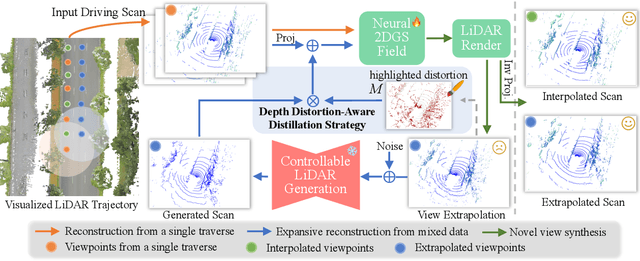
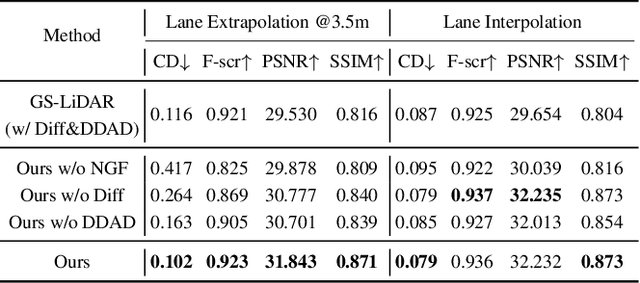
Abstract:Recent GS-based rendering has made significant progress for LiDAR, surpassing Neural Radiance Fields (NeRF) in both quality and speed. However, these methods exhibit artifacts in extrapolated novel view synthesis due to the incomplete reconstruction from single traversal scans. To address this limitation, we present LiDAR-GS++, a LiDAR Gaussian Splatting reconstruction method enhanced by diffusion priors for real-time and high-fidelity re-simulation on public urban roads. Specifically, we introduce a controllable LiDAR generation model conditioned on coarsely extrapolated rendering to produce extra geometry-consistent scans and employ an effective distillation mechanism for expansive reconstruction. By extending reconstruction to under-fitted regions, our approach ensures global geometric consistency for extrapolative novel views while preserving detailed scene surfaces captured by sensors. Experiments on multiple public datasets demonstrate that LiDAR-GS++ achieves state-of-the-art performance for both interpolated and extrapolated viewpoints, surpassing existing GS and NeRF-based methods.
Human-in-Context: Unified Cross-Domain 3D Human Motion Modeling via In-Context Learning
Aug 14, 2025Abstract:This paper aims to model 3D human motion across domains, where a single model is expected to handle multiple modalities, tasks, and datasets. Existing cross-domain models often rely on domain-specific components and multi-stage training, which limits their practicality and scalability. To overcome these challenges, we propose a new setting to train a unified cross-domain model through a single process, eliminating the need for domain-specific components and multi-stage training. We first introduce Pose-in-Context (PiC), which leverages in-context learning to create a pose-centric cross-domain model. While PiC generalizes across multiple pose-based tasks and datasets, it encounters difficulties with modality diversity, prompting strategy, and contextual dependency handling. We thus propose Human-in-Context (HiC), an extension of PiC that broadens generalization across modalities, tasks, and datasets. HiC combines pose and mesh representations within a unified framework, expands task coverage, and incorporates larger-scale datasets. Additionally, HiC introduces a max-min similarity prompt sampling strategy to enhance generalization across diverse domains and a network architecture with dual-branch context injection for improved handling of contextual dependencies. Extensive experimental results show that HiC performs better than PiC in terms of generalization, data scale, and performance across a wide range of domains. These results demonstrate the potential of HiC for building a unified cross-domain 3D human motion model with improved flexibility and scalability. The source codes and models are available at https://github.com/BradleyWang0416/Human-in-Context.
MIND: A Noise-Adaptive Denoising Framework for Medical Images Integrating Multi-Scale Transformer
Aug 13, 2025Abstract:The core role of medical images in disease diagnosis makes their quality directly affect the accuracy of clinical judgment. However, due to factors such as low-dose scanning, equipment limitations and imaging artifacts, medical images are often accompanied by non-uniform noise interference, which seriously affects structure recognition and lesion detection. This paper proposes a medical image adaptive denoising model (MI-ND) that integrates multi-scale convolutional and Transformer architecture, introduces a noise level estimator (NLE) and a noise adaptive attention module (NAAB), and realizes channel-spatial attention regulation and cross-modal feature fusion driven by noise perception. Systematic testing is carried out on multimodal public datasets. Experiments show that this method significantly outperforms the comparative methods in image quality indicators such as PSNR, SSIM, and LPIPS, and improves the F1 score and ROC-AUC in downstream diagnostic tasks, showing strong prac-tical value and promotional potential. The model has outstanding benefits in structural recovery, diagnostic sensitivity, and cross-modal robustness, and provides an effective solution for medical image enhancement and AI-assisted diagnosis and treatment.
Does Your 3D Encoder Really Work? When Pretrain-SFT from 2D VLMs Meets 3D VLMs
Jun 06, 2025

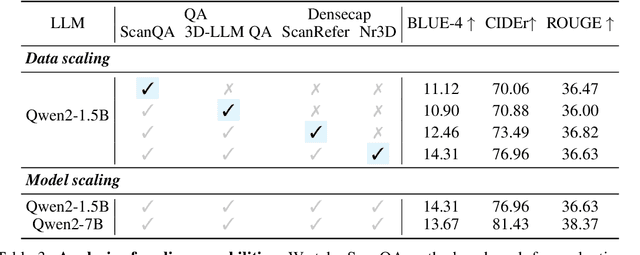
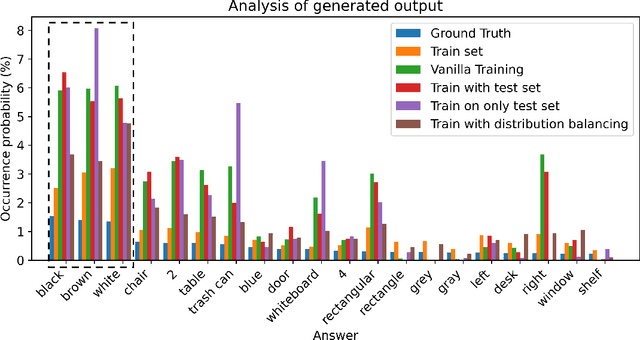
Abstract:Remarkable progress in 2D Vision-Language Models (VLMs) has spurred interest in extending them to 3D settings for tasks like 3D Question Answering, Dense Captioning, and Visual Grounding. Unlike 2D VLMs that typically process images through an image encoder, 3D scenes, with their intricate spatial structures, allow for diverse model architectures. Based on their encoder design, this paper categorizes recent 3D VLMs into 3D object-centric, 2D image-based, and 3D scene-centric approaches. Despite the architectural similarity of 3D scene-centric VLMs to their 2D counterparts, they have exhibited comparatively lower performance compared with the latest 3D object-centric and 2D image-based approaches. To understand this gap, we conduct an in-depth analysis, revealing that 3D scene-centric VLMs show limited reliance on the 3D scene encoder, and the pre-train stage appears less effective than in 2D VLMs. Furthermore, we observe that data scaling benefits are less pronounced on larger datasets. Our investigation suggests that while these models possess cross-modal alignment capabilities, they tend to over-rely on linguistic cues and overfit to frequent answer distributions, thereby diminishing the effective utilization of the 3D encoder. To address these limitations and encourage genuine 3D scene understanding, we introduce a novel 3D Relevance Discrimination QA dataset designed to disrupt shortcut learning and improve 3D understanding. Our findings highlight the need for advanced evaluation and improved strategies for better 3D understanding in 3D VLMs.
MolLangBench: A Comprehensive Benchmark for Language-Prompted Molecular Structure Recognition, Editing, and Generation
May 21, 2025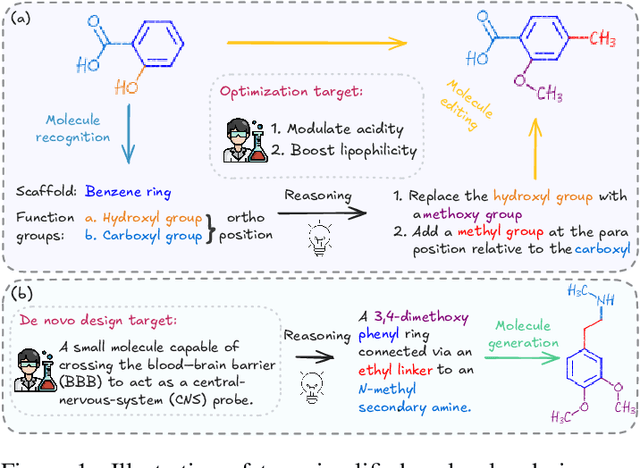
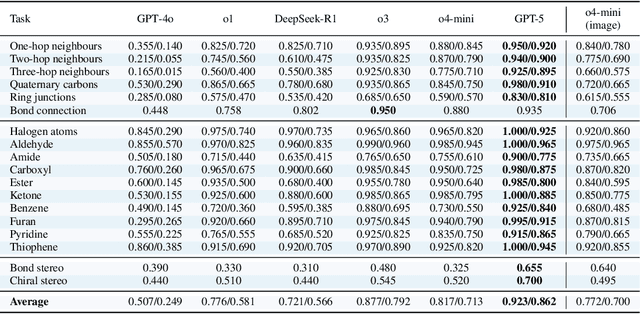
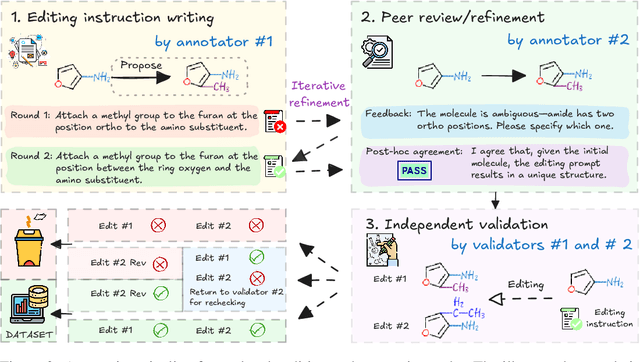

Abstract:Precise recognition, editing, and generation of molecules are essential prerequisites for both chemists and AI systems tackling various chemical tasks. We present MolLangBench, a comprehensive benchmark designed to evaluate fundamental molecule-language interface tasks: language-prompted molecular structure recognition, editing, and generation. To ensure high-quality, unambiguous, and deterministic outputs, we construct the recognition tasks using automated cheminformatics tools, and curate editing and generation tasks through rigorous expert annotation and validation. MolLangBench supports the evaluation of models that interface language with different molecular representations, including linear strings, molecular images, and molecular graphs. Evaluations of state-of-the-art models reveal significant limitations: the strongest model (o3) achieves $79.2\%$ and $78.5\%$ accuracy on recognition and editing tasks, which are intuitively simple for humans, and performs even worse on the generation task, reaching only $29.0\%$ accuracy. These results highlight the shortcomings of current AI systems in handling even preliminary molecular recognition and manipulation tasks. We hope MolLangBench will catalyze further research toward more effective and reliable AI systems for chemical applications.
Integral regularization PINNs for evolution equations
Mar 31, 2025Abstract:Evolution equations, including both ordinary differential equations (ODEs) and partial differential equations (PDEs), play a pivotal role in modeling dynamic systems. However, achieving accurate long-time integration for these equations remains a significant challenge. While physics-informed neural networks (PINNs) provide a mesh-free framework for solving PDEs, they often suffer from temporal error accumulation, which limits their effectiveness in capturing long-time behaviors. To alleviate this issue, we propose integral regularization PINNs (IR-PINNs), a novel approach that enhances temporal accuracy by incorporating an integral-based residual term into the loss function. This method divides the entire time interval into smaller sub-intervals and enforces constraints over these sub-intervals, thereby improving the resolution and correlation of temporal dynamics. Furthermore, IR-PINNs leverage adaptive sampling to dynamically refine the distribution of collocation points based on the evolving solution, ensuring higher accuracy in regions with sharp gradients or rapid variations. Numerical experiments on benchmark problems demonstrate that IR-PINNs outperform original PINNs and other state-of-the-art methods in capturing long-time behaviors, offering a robust and accurate solution for evolution equations.
UniGS: Unified Language-Image-3D Pretraining with Gaussian Splatting
Feb 25, 2025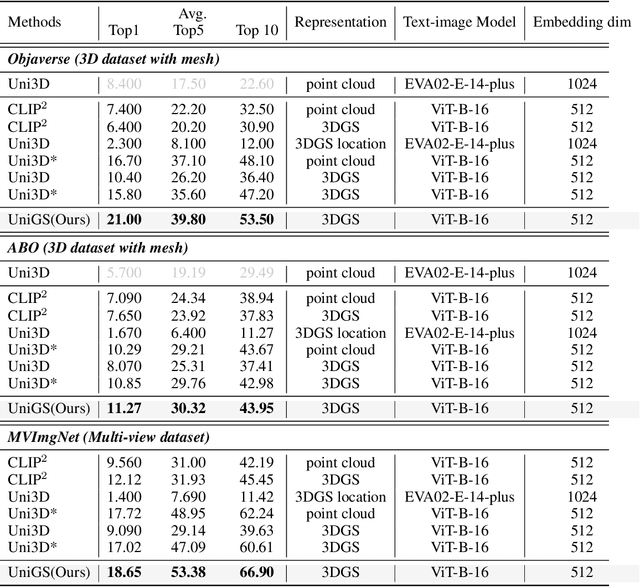

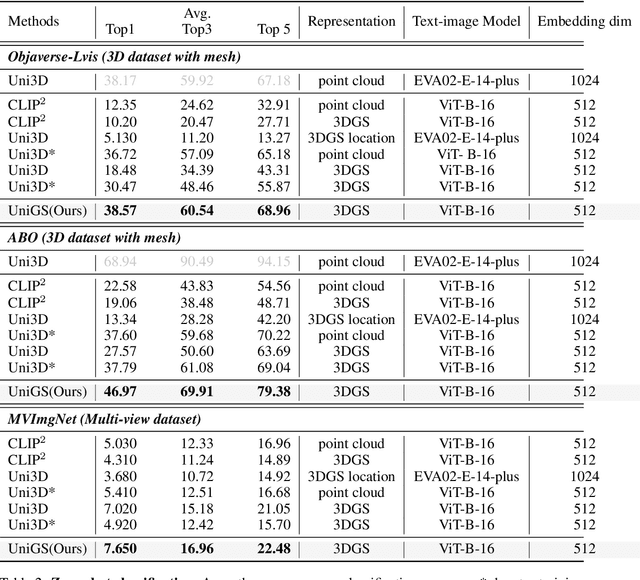

Abstract:Recent advancements in multi-modal 3D pre-training methods have shown promising efficacy in learning joint representations of text, images, and point clouds. However, adopting point clouds as 3D representation fails to fully capture the intricacies of the 3D world and exhibits a noticeable gap between the discrete points and the dense 2D pixels of images. To tackle this issue, we propose UniGS, integrating 3D Gaussian Splatting (3DGS) into multi-modal pre-training to enhance the 3D representation. We first rely on the 3DGS representation to model the 3D world as a collection of 3D Gaussians with color and opacity, incorporating all the information of the 3D scene while establishing a strong connection with 2D images. Then, to achieve Language-Image-3D pertaining, UniGS starts with a pre-trained vision-language model to establish a shared visual and textual space through extensive real-world image-text pairs. Subsequently, UniGS employs a 3D encoder to align the optimized 3DGS with the Language-Image representations to learn unified multi-modal representations. To facilitate the extraction of global explicit 3D features by the 3D encoder and achieve better cross-modal alignment, we additionally introduce a novel Gaussian-Aware Guidance module that guides the learning of fine-grained representations of the 3D domain. Through extensive experiments across the Objaverse, ABO, MVImgNet and SUN RGBD datasets with zero-shot classification, text-driven retrieval and open-world understanding tasks, we demonstrate the effectiveness of UniGS in learning a more general and stronger aligned multi-modal representation. Specifically, UniGS achieves leading results across different 3D tasks with remarkable improvements over previous SOTA, Uni3D, including on zero-shot classification (+9.36%), text-driven retrieval (+4.3%) and open-world understanding (+7.92%).
Foundation Models for Anomaly Detection: Vision and Challenges
Feb 10, 2025



Abstract:As data continues to grow in volume and complexity across domains such as finance, manufacturing, and healthcare, effective anomaly detection is essential for identifying irregular patterns that may signal critical issues. Recently, foundation models (FMs) have emerged as a powerful tool for advancing anomaly detection. They have demonstrated unprecedented capabilities in enhancing anomaly identification, generating detailed data descriptions, and providing visual explanations. This survey presents the first comprehensive review of recent advancements in FM-based anomaly detection. We propose a novel taxonomy that classifies FMs into three categories based on their roles in anomaly detection tasks, i.e., as encoders, detectors, or interpreters. We provide a systematic analysis of state-of-the-art methods and discuss key challenges in leveraging FMs for improved anomaly detection. We also outline future research directions in this rapidly evolving field.
 Add to Chrome
Add to Chrome Add to Firefox
Add to Firefox Add to Edge
Add to Edge